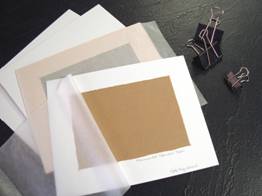 Photo 1
Photo 1
The bottom two boards are ³⁄₁₆" foam center boards; the next is mounted pastel paper covered with glassine; and the front board shows glassine folded back to expose mounted paper.
Pastel is a sensitive medium. Professional framers are routinely warned against even laying a pastel package face down during the fitting stage of framing for fear that pigment dust might drop onto the back of the glass when it is being stapled closed. Obviously originals are not always framed when first being transported. In fact they must be carried to the framer in order to be framed. Transport of both framed and unframed pastels is a challenge at best, and when hand delivery is not an option there are methods for transport that are designed for maximum protection with minimal damage or pigment loss.
Sanded paper is easiest to care for when it has been mounted to a 4-ply or 8-ply rag backing prior to applying any pastel pigment (photo 1). Working on mounted sanded paper panels makes the later transport of unframed plein-air or incomplete pastels is made possible without damage by use of sandwiching.
 Photo 1
Photo 1
The bottom two boards are ³⁄₁₆" foam center boards; the next is mounted pastel paper covered with glassine; and the front board shows glassine folded back to expose mounted paper.
Cover, Carry or Store
Whether transporting a painting from a plein-air location, to the framer, or shipping to a client, knowing how to safely transport a pastel is vital. Glassine is the best material to cover a pastel. It is a translucent, water resistant, and air resistant paper which is slick and not prone to static or pigment transfer. Avoid tracing paper, wax paper or plain paper because of active pigment transfer.
Attach the glassine cover sheet by taping one end of it 1-2" around the end of the mount board and firmly tape to the back. Smoothly lay the glassine across the pastel, wrap around the other end and attach to the back. Multiple pastels may then be gently stacked on top of each other, then covered with slightly larger sheets of ³⁄₁₆" foam center board and firmly held together with binder clips (photo 2). It is the attachment of the cover sheet and locking of the stacked layers that keeps the pigment from flaking, dusting or rubbing off during storage or transport.
 Photo 2
Photo 2
Cover the pastel with glassine and tape it to the back. Align the two foam boards and clip edges to prevent slipping.
Shipping Framed Art
In a perfect world all framed originals could be hand carried to their display destination, but sometimes these pieces require shipping..as to competitions, galleries or distant collectors. There is a sad misconception that the rigidity of the packaging exterior is the major element which prevents damage during shipping…which is not the case. When a corrugated cardboard box is lined—on all sides, top and bottom—with ¼" plywood, and stacked full of sheets of 1" sheets of polystyrene, the shipping box is very solid. But any exterior concussion or trauma is transferred through all those rigid layers directly to the art at the center of that box, no matter how thick (photo 3).
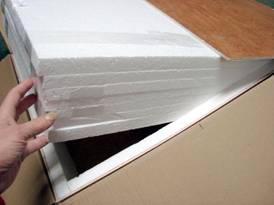 Photo 3
Photo 3
The cardboard box is lined on all sides, the top and bottom with ¼" plywood, and is stacked full of 1" polystyrene sheets, making a very rigid package.
The glass art in the sample has been wrapped in multiple layers of newsprint paper then sandwiched snuggly between the layers of Styrofoam as padding (photo 4). Even with 3" of surrounded boards and foam there is not enough actual cushion to prevent concussion (photo 5).
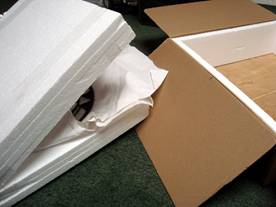 Photo 4
Photo 4
Here, glass art is sandwiched between layers of polystyrene foam to be placed into a plywood lined, double strength cardboard box.
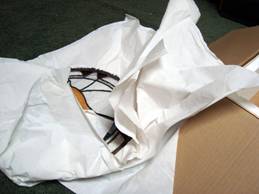 Photo 5
Photo 5
The paper will cushion this flat art better than some, but concussion can still affect the inner art.
Generally the shipping box and wrapping materials must be capable of tolerating a fall of ten feet in order to meet most company shipping requirements. But beyond the prevention of broken glass or a popped frame corner, the challenge with a pastel, is the delicacy of the medium. Any hard blow can dislodge pigment onto the inside of the glass or along an exposed bevel if a spacer and reverse bevel have not been used. (see TPJ June 2010, "How To Speak Framer"). Hence the padding surrounding the art must absorb the concussion so it never reaches the framed pastel at the center.
Bubble wrap features encapsulated air which provides decent cushioning against shock and abrasion. Use multiple layers of wrap in both directions for a full 2" around the frame and from the box wall. Corrugated liners and inserts may be added around the perimeter of the package to increase box strength and improve package performance, but should not be considered additional cushioning. Though UPS and FedEx may recommend crumpled Kraft paper and newspaper/newsprint for some shipping, it should be avoided for framed art, and shredded paper is messy and very ineffective.
Loose fill—pellets or peanuts—is a terrible, messy invention, but it is lightweight and does give decent cushion. They are recommended dominantly for use with non-fragile items such as books…but not glassed frames. There are many arguments against the use of pellets. They can compress and settle during shipping allowing for art to shift during transport and they create static electricity—though anti-static pellets are available. It is highly recommended NEVER to use pellets whenever framed art is being shipped, and is to be returned after display, as the unpacking and repacking causes a great deal mess. It should also be noted that some galleries and museums may even disqualify shipped art if pellets have been used. Bottom line, galleries frown upon any use of wadded paper, pellets, taped bubble wrap or boxes within boxes.
Glass Support
When shipping framed art, precautions must be taken to protect from glass breakage. One common suggestion is to tape the glass to help hold the pieces together if broken during shipping, but not all tapes are created equal. Selecting a high tack clear shipping tape can leave sticky residue, while a low tack blue masking tape might not hold securely enough to prevent glass shards from damaging the art. A simple crisscross of the tape does not cover enough area and cannot hold broken glass in areas not in contact with the tape. Use parallel strips of overlapping tape and cover the entire piece of glass. Also be careful not to contact the frame with the tape as it could damage the moulding finish when removed.
There are commercial products that have been developed for use when shipping glass. Patco 5560 is a moderate tack tape used for temporary surface protection during shipping. It is an affordable, removable polyethylene protective film which is abrasion, moisture and solvent resistant; removes easily and cleanly leaving no adhesive residue; and readily conforms to irregular surfaces. It is easily found on the internet. Glas-Skin from Airfloat Systems is a professional 12" wide, 100 yard long roll of protective film, that is applied directly to the entire surface area of the glass. It is moderate in tack, easily applied and removed.
Cushioned Boxes
For small framed art, commercial corrugated containers such as the Airfloat Strongboxare available providing the strength of plywood without the weight. It has two layers of convoluted—eggcrate—foam with a third layer of perforated foam squares for custom fitting framed art. They are available with single-wall and double-wall corrugated construction and are tough, reusable boxes.
Self-made, hinged boxes are perfect for shipping framed art (photo 6), as they are custom sized to the art and reusable. The best boxes are built using ½" foam board and should be sized to allow a for 1½" to 2" of sponge padding on all sides, top and bottom of the frame. Eggcrate foam is best for padding the inside of the box because of its contoured design, which more readily conforms to the odd shape of some mouldings and the recessed glazing and backing.
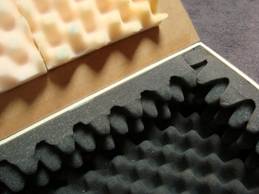 Photo 6
Photo 6
This box was constructed with white and brown Kraft Gatorboard (foam center board is an even sturdier choice). Gray commercial eggcrate insulation lines the box base; bed sponge is shown on top.
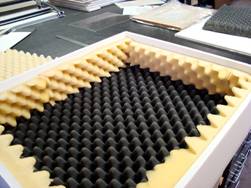 Photo 7
Photo 7
The box is lined on the bottom, sides and top with 2.-inch convoluted foam. The yellow is soft mattress padding, while the gray is more dense, acoustic foam.
Once the box pieces are all cut to size, assemble it by hot gluing all pieces together, then reinforce all seams with 2" shipping tape. Burnish all tapes once applied to fully activate the pressure-sensitive adhesive. Eggcrate foam is the best for lining a box. Soft mattress eggcrate padding is available from home stores and gray acoustic convoluted foam is available up to 2½" thick online. Cut large pieces of eggcrate foam to fit the bottom and top of the box (photo 7) and hold in position using hot glue around the outer perimeter of the foam. The sides of the box should also be lined creating a custom sized cradle for the artwork (photo 8). The peaks and valleys of the eggcrate shape helps suspend the frame and allows for maximum cushioning.
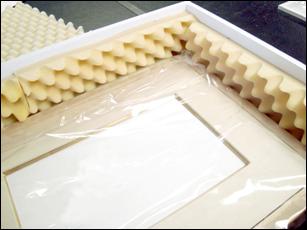 Photo 8
Photo 8
Foam center board has a cushion and is more forgiving than other rigid materials, making it the best choice for a shipping box. This ½" thick foam box has been lined with 2½" eggcrate foam.
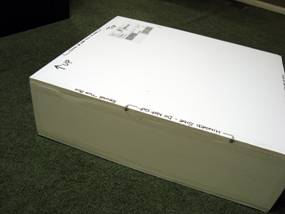 Photo 9
Photo 9
The sealed hinged box is ready to ship. It has been taped with 2" wide heavy duty packing tape and marked to indicate the hinged side, score sides and top.
Other Options
The frame should be placed in a strong plastic bag—designed for art—to help protect from moisture and scratching when shipped. Avoid using additional layers of corrugate or foam board around the frame which may disallow the eggcrate foam from conforming to the shape of the frame. Some people like to build their boxes using Gatorboard thinking it is more rigid and will protect better, but the veneer that is on either side of the foam center is more brittle and rather than absorbing concussion will often fracture or puncture. Clay coated ½" foam center board gives under pressure which absorbs concussion better, and the ½" thickness is also a fabulous insulator against heat and cold.
Place all receipts, entry forms, return information/labels, fees, and box information in a manila envelope inside with the frame before sealing the box. Seal the edges of the closed lid with 2" shipping tape and make certain to also burnish all of these edges to activate the adhesive, as a quick slide of the hand will only activate about 25% of the adhesive bond. Be sure to label the box clearly with shipping and return addresses, include phone numbers, mark it top and bottom, and note it is fragile.
Sometimes the true beauty of a medium comes with understanding the special care required to maintain it after completion. The execution of a masterpiece is only the first step. The follow-through in the case of pigmented, unfixed pastels is the knowing of how to frame with spacers and reverse bevels; transporting unframed pieces with glassine covering; and shipping with eggcrate lined boxes that makes the life of a pastel artist happier.
END
Copyright © 2012 Chris A Paschke
Resources—Items
Airfloat Systems Inc.—and Glas-Skin
Berry Plastics Corporation—Patco 5560 Removable Tape (MSDS)
The Foam Factory—Charcoal Acoustic Eggcrate Foam
Shipping Box Instructions
Paschke, Chris A, CPF GCF, Creative Mounting, Wrapping And Laminating, 1999
Step-by-step directions for Hinged Box, Drop Spine Box and Sink Box
http://designsinkart.com/books
For more articles on mounting basics look under the mounting section in Articles by Subject.
Additional information on all types of mounting is found in:
The Mounting and Laminating Handbook, Second Edition, 2002,
The Mounting And Laminating Handbook, Third Edition, 2008 and
Creative Mounting, Wrapping, And Laminating, 2000 will teach you everything you need to know about getting the most from your dry mount equipment and materials as an innovative frame designer.
All books are available from Designs Ink Publishing through this website.
Chris A Paschke, CPF GCF
Designs Ink
Designs Ink Publishing
785 Tucker Road, Suite G-183
Tehachapi, CA 93561
P 661-821-2188
chris@designsinkart.com